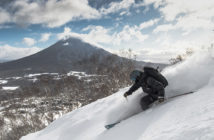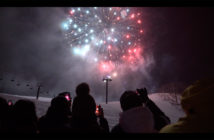The Niseko area is mainly temperate, broadleaf, and mixed forests, boasting many trees which are “deciduous“ (trees that shed their leaves) and a few species of “coniferous“ trees which are generally evergreen and keep their leaves during winter, one exception here being the larch trees that turn a stunning golden colour before shedding their needles in late autumn.
The Northern parts of Hokkaido are classed as sub-boreal and are in turn in the lower regions of the boreal forest which is the largest terrestrial biome on the planet. Boreal forests are classified as an ecosystem with a sub-arctic climate in the Northern Hemisphere, a band of forest that spreads across the northern parts of the world and is often referred to as the “taiga“. Some familiar countries with boreal forests are places like Alaska, Canada, Russia, and Scandinavian and Nordic countries like Sweden, Finland, and Norway.
Our close proximity to the boreal forest gives Hokkaido a wonderful array of similar plants, trees and animals for us all to enjoy and respect; large mammals such as brown bear and deer plus the usual suspects of the fox, tanuki, red squirrel, flying squirrel, marten, weasel, ermine, mountain hare, voles & mice just to name a few.
The beauty of Niseko and its wildlife can be appreciated with the changes that come with the four distinct seasons. With relatively few inhabitants during winter – most of the birds have migrated to warmer climates, many of the smaller animals take refuge insulated from the weather under the thick layers of snow that blanket the landscape during our harsh long winter, eking out an existence under the snow through a maze of tunnels and passages and coming to the surface occasionally to forage, when they in turn become potential prey for the foxes, marten and numerous birds of prey that are still active in the area during winter. Snowshoeing in the winter forest is a wonderful experience, reading the tracks left by the animals in the snow gives an insight into who is around, often if you sit still for a few minutes in silence, some of them, unaware of your presence might reveal themselves to you.
Some animals go into hibernation, and either sleep through the long cold winter without feeding; living off the fat resources they have stored during the plentiful seasons of summer and autumn or small animals like rodents tend to have food caches stored under the snow and spend varying lengths of time in hibernation depending on factors like species, time of year, temperature and individual health, hoping to awaken to a spring also filled with food and opportunity to help nourish them and their often new offspring which many of them give birth to during or just after hibernation.
With the coming of spring, the once quiet snow-covered fields and rivers of the Niseko area, start to come to life with the influx of migratory birds that are returning for the bug banquet that is preparing to emerge from its slumber. The cycle is beginning again and many newly born animals whose arrival into this world has been carefully timed through millions of years of evolution are now reaping the rewards that spring has to offer, some though, like the red squirrels take advantage of the seeds and nuts that are associated with autumn also and can raise two separate litters a year in spring and autumn, using all the available resources of the seasons.
The trees and plants, which also, for the most part have been dormant during winter now emerge en-masse with growth rates of astounding speed turning a once white canvas into a wash of colour dominated by green but also splashed with the pinks and whites of the cherry blossoms, the yellows and orange hues of the various different types of maple trees as their leaves unfurl are reminiscent of the colours of autumn, however it is spring, I like to refer to this brief period as “Sprautumn“ a truly refreshing time of year when many of the local human residents start to forage for wild edible foods.
Sansai which translates to “mountain vegetables“ become abundant at this time of year. Many of the more popular sansai are now commercially cultivated and sold packaged in supermarkets all year round at high prices; however picking and enjoying them fresh is often an activity carried out by locals in spring with the bounty shared amongst friends, family and co-workers alike.
Sansai picking is a whole other topic and not in the scope of this writing, but a word of warning to all people consuming wild edible foods is that you must know without a doubt 100% what something is before eating it. Always seek advice from a local expert before consuming anything you are not 100% certain of its identity, many wild plants have look-a-likes that are highly poisonous and can make you very sick, or can even cause death.
As spring rolls into summer the area becomes abuzz with insect life, notably the sophisticated song of the male cicadas which resonates from the tree tops in hypnotic rhythmical patterns designed to attract an optimal mate of the same species. Cicadas spend most of their lives as a nymph buried underground for several to many years feeding on sap from tree roots only emerge for the last act of mating, when the female lays hundreds of eggs inside tree bark, which once hatched drop to the ground and bury themselves repeating the cycle again – some cicadas are known to stay buried in the nymph stage for up to 17 years before emerging to mate – wow!
As summer boosts into full swing with long days and pleasing weather for the most part, reptiles and amphibians are also especially active. Japanese tree frogs and Ezo brown frogs vocally advertise their availability in the early evenings and move to lit areas in order to catch insects attracted by the lights. The Japanese rat snake or Ao Daisho (“Green General“) is also on the prowl looking for small birds, rodents insects and indeed the frogs as well, although generally feared and often killed out of ignorance, the rat snake is not poisonous and if given the chance wants nothing more than to to get out of your way.
Hokkaido is also home to the venomous Mamushi, or pit viper and although they are not very prevalent in this area there are some around so if you do see a snake the best and safest thing to do, for you and the snake, is just to admire it from a distance and leave it be.
Enjoying the summer season is easy in Hokkaido where BBQ’ing with friends, festivals, camping and fishing, mountain hiking and mountain biking are the norm for many locals, it’s important to try to get your fill of the summer nature, try to breath it all in, as much as you can, the seasons are fleeting and before you know it the days are starting to get shorter, the evenings becoming cooler triggering the change into autumn ,without a doubt, the most spectacular season, with it’s unrivalled colours, and golden sunsets.
Autumn is the last chance for many of the smaller animals to stock up on seeds and nuts, for the bears to feast on berries, insects and salmon in order to fatten up for the long hibernation they must endure during the coming winter, the trees start to lose their leaves with a spectacular display of colours from reds to purples, oranges, yellows and yet there is always the ever constant greens of the evergreens that again remind us of our connection to the boreal forests. Many birds start to migrate again, heading for the warmer climates to wait out the winter, yet some like the impressive Steller’s sea eagle and white tailed eagles choose the winter as a time to visit, when they mostly inhabit the northern areas of Hokkaido and come to breed, and to feed on the abundant Pacific cod which are most numerous in the Rausu Sea and the Nemuro Straits in February. Autumn is the time for many animals to exchange their summer plumage or summer coats for a warmer more practical attire and indeed without this ability would perish in the sub zero temperatures of Hokkaido winters, some well adapted animals also have the ability change the colour of their fur or feathers to white in a bid to stay camouflaged against the snow and hide in plain sight.
Winter is here again, the snows begin to fall and will continue to do so for many months, the white blanket is back, the animals, insects, trees and plants are mostly hidden from view, the trees now mostly free from leaves have pushed all their sap back into their roots in order to protect themselves from freezing and to withstand the long winter, mostly, things are quiet now, everything is poised and awaiting the return of spring.




